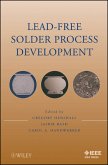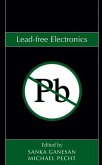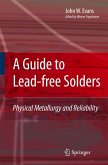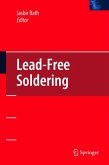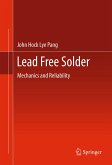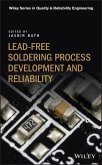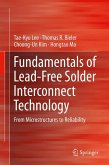Lead-Free Electronics (eBook, PDF)
iNEMI Projects Lead to Successful Manufacturing


Alle Infos zum eBook verschenken

Lead-Free Electronics (eBook, PDF)
iNEMI Projects Lead to Successful Manufacturing
- Format: PDF
- Merkliste
- Auf die Merkliste
- Bewerten Bewerten
- Teilen
- Produkt teilen
- Produkterinnerung
- Produkterinnerung

Hier können Sie sich einloggen

Bitte loggen Sie sich zunächst in Ihr Kundenkonto ein oder registrieren Sie sich bei bücher.de, um das eBook-Abo tolino select nutzen zu können.
Based on the results of a more than two-year study, Lead-Free Electronics: iNEMI Projects Lead to Successful Manufacturing is the first practical, primary reference to cover Pb-free solder assembly as well as the analysis and reasoning behind the selection of Sn-Ag-Cu as the recommended Pb-free replacement for Sn-Pb. Reflecting the results of a two-year study, Lead-Free Electronics: iNEMI Projects Lead to Successful Manufacturing provides full coverage of the issues surrounding the implementation of Pb-free solder into electronic board assembly. This book is extremely timelyâ??most electronic…mehr
- Geräte: PC
- mit Kopierschutz
- eBook Hilfe
- Größe: 13.96MB
![Lead-Free Solder Process Development (eBook, PDF) Lead-Free Solder Process Development (eBook, PDF)]() Lead-Free Solder Process Development (eBook, PDF)107,99 €
Lead-Free Solder Process Development (eBook, PDF)107,99 €![Lead-free Electronics (eBook, PDF) Lead-free Electronics (eBook, PDF)]() Lead-free Electronics (eBook, PDF)145,99 €
Lead-free Electronics (eBook, PDF)145,99 €![A Guide to Lead-free Solders (eBook, PDF) A Guide to Lead-free Solders (eBook, PDF)]() John W. EvansA Guide to Lead-free Solders (eBook, PDF)73,95 €
John W. EvansA Guide to Lead-free Solders (eBook, PDF)73,95 €![Lead-Free Soldering (eBook, PDF) Lead-Free Soldering (eBook, PDF)]() Lead-Free Soldering (eBook, PDF)73,95 €
Lead-Free Soldering (eBook, PDF)73,95 €![Lead Free Solder (eBook, PDF) Lead Free Solder (eBook, PDF)]() John Hock Lye PangLead Free Solder (eBook, PDF)73,95 €
John Hock Lye PangLead Free Solder (eBook, PDF)73,95 €![Lead-free Soldering Process Development and Reliability (eBook, PDF) Lead-free Soldering Process Development and Reliability (eBook, PDF)]() Lead-free Soldering Process Development and Reliability (eBook, PDF)117,99 €
Lead-free Soldering Process Development and Reliability (eBook, PDF)117,99 €![Fundamentals of Lead-Free Solder Interconnect Technology (eBook, PDF) Fundamentals of Lead-Free Solder Interconnect Technology (eBook, PDF)]() Tae-Kyu LeeFundamentals of Lead-Free Solder Interconnect Technology (eBook, PDF)73,95 €
Tae-Kyu LeeFundamentals of Lead-Free Solder Interconnect Technology (eBook, PDF)73,95 €-
-
-
Dieser Download kann aus rechtlichen Gründen nur mit Rechnungsadresse in A, B, BG, CY, CZ, D, DK, EW, E, FIN, F, GR, HR, H, IRL, I, LT, L, LR, M, NL, PL, P, R, S, SLO, SK ausgeliefert werden.
Hinweis: Dieser Artikel kann nur an eine deutsche Lieferadresse ausgeliefert werden.
- Produktdetails
- Verlag: Wiley-Blackwell
- Seitenzahl: 472
- Erscheinungstermin: 28. Juni 2008
- Englisch
- ISBN-13: 9780470171462
- Artikelnr.: 38187321
- Verlag: Wiley-Blackwell
- Seitenzahl: 472
- Erscheinungstermin: 28. Juni 2008
- Englisch
- ISBN-13: 9780470171462
- Artikelnr.: 38187321
- Herstellerkennzeichnung Die Herstellerinformationen sind derzeit nicht verfügbar.
Contributors.
Introduction (Jasbir Bath and Carol A. Handwerker).
Lead-Free Assembly Project.
Alloy Group.
Process Group.
Component Group.
Reliability Group.
Follow-On Projects/Work.
1. Alloy Selection (Carol A. Handwerker, Ursula Kattner, Kilwon Moon,
Jasbir Bath, Edwin Bradley, and Polina Snugovsky).
1.1. Introduction.
1.2. Lead-Free Alloys Considered by iNEMI in 1999 as Replacements for
Tin-Lead Eutectic Solder.
1.3. Fundamental Properties of Lead-Free Solder Alloys Affecting
Manufacturing and Reliability.
1.4. R&D Issues Remaining in Lead-Free Solder Implementation.
1.5. Summary.
References.
2. Review and Analysis of Lead-Free Solder Material Properties (Jean-Paul
Clech).
2.1. Introduction.
2.2. Tin-Lead Properties and Models.
2.3. Tin-Silver Properties and Creep Data.
2.4. Tin-Silver-Copper Properties and Creep Data.
2.5. Alloy Comparisons.
2.6. General Conclusions/Recommendations.
Appendix A: Tin-Silver Creep Data.
Appendix B: Tin-Silver-Copper Creep Data.
Acknowledgments.
References.
3. Lead-Free Solder Paste Technology (Ning-Cheng Lee).
3.1. Introduction.
3.2. Materials.
3.3. Rheology.
3.4. Applications.
3.5. Reflow Soldering.
3.6. Microstructures of Reflowed Joints.
3.7. Challenges of Lead-Free Reflow Soldering.
3.8. Summary.
References.
4. Impact of Elevated Reflow Temperatures on Component Performance
(Richard D. Parker, Jack MCCullen, Nick Lycoudes, and R. J. Arvikar).
4.1. Introduction to Component "Lead-Free" Issues.
4.2. Moisture/Reflow Impact on Packaged Integrated Circuits.
4.3. Impact of Increased Solder Peak Reflow Temperatures on Moisture
Sensitivity Level Ratings.
4.4. Impact of Increased Solder Peak Reflow Temperatures.
4.5. Observations on Profiling for the Lead-Free Reflow Processes.
4.6. IC Package Improvement Options for Better Package MSL at Higher
Lead-Free Solder Reflow Temperatures.
4.7. Frequency Control Products.
4.8. "Lead-Free" Cost Impact on Components.
4.9. Packaging Identification of Lead-free Packaged ICs.
4.10. Conclusions.
Acknowledgments.
References.
5. Lead-Free Assembly Reliability-General (Edwin Bradley).
5.1. Introduction.
5.2. Basic Physical Properties of Solder.
5.3. Creep Deformation.
5.4. Thermal Fatigue.
5.5. Creep Rupture.
5.6. Isothermal (Mechanical) Fatigue.
5.7. Out-of-Plane Bending.
5.8. Impact/Shock Loading.
5.9. Effect of Rework on Reliability.
5.10. High-Temperature Operating Life (HTOL).
5.11. Electrochemical Migration.
5.12. Tin Whiskering.
5.13. Tin Pest.
5.14. Summary.
Acknowledgments.
References.
6. Lead-Free Assembly Reliability: iNEMI Evaluation and Results (Elizabeth
Benedetto and John Sohn).
6.1. Reliability Team Goals.
6.2. Reliability Test Matrix.
6.3. Component-Paste-Board Finish Combinations.
6.4. Components.
6.5. Test Vehicles.
6.6. Pre-Test/Post-Assembly Information.
6.7. CTE Determination: Component and Boards.
6.8. Thermal Cycling Conditions.
6.9. Failure Criteria.
6.10. Thermal Cycle Relative Performance.
6.11. Failure Data, Analysis Packages.
6.12. Weibull Analyses.
6.13. Post-Cycling Failure Analysis.
6.14. Bend Testing.
6.15. Electrochemical Migration Testing [36, 37].
6.16. iNEMI Team Conclusions.
6.17. Overall Summary, Conclusions.
6.18. ASTM Test Methods.
References.
7. Tin Whiskers: Mitigation Strategies and Testing (Heidi L. Reynolds, C.
J. Lee, and Joe Smetana).
7.1. Introduction.
7.2. Mitigation Strategies.
7.3. Tin Whisker Test Development.
7.4. Summary.
Acknowledgments.
References.
8. Lead-Free Reflow and Rework (Jasbir Bath).
8.1. Introduction.
8.2. Printability of Lead-Free Solder Pastes.
8.3. Soak Versus Ramp Temperature Profiles.
8.4. Effect of Peak Temperature Versus Reflow Performance.
8.5. Effect of Reflow Atmosphere on Solderability of Lead-Free Solder.
8.6. Convection Versus IR Reflow Ovens.
8.7. Reflow Temperature Delta on Boards and Components.
8.8. Visual Inspection of Lead-Free Soldered Joints.
8.9. Automated Optical Inspection (AOI).
8.10. X-ray Inspection of Lead-Free Soldered Joints.
8.11. Acoustic Microscopy Inspection of Components Before and After
Lead-Free Reflow.
8.12. Lead-Free Rework of BGA/CSP Soldered Joints.
8.13. Lead-Free Hand-Soldering Rework.
8.14. In-Circuit Testing and Functional Testing (ICT/FT) of Soldered
Joints.
8.15. Yield Data.
8.16. Surface-Mount Fillet Lifting and Reliability of Reflowed Soldered
Joints.
8.17. Conclusions.
8.18. Future Work.
Acknowledgments.
References.
9. Case Study: Pb-Free Assembly, Rework, and Reliability Analysis of IPC
Class 2 Assemblies (Jerry Gleason, Charlie Reynolds, Matt Kelly, Jasbir
Bath, Quyen Chu, Ken Lyjak, and Patrick Roubaud).
9.1. Introduction.
9.2. Approach and Strategy.
9.3. Observations and Results.
9.4. Conclusions.
9.5. Summary.
Acknowledgments.
References.
10. Implementing RoHS and WEEE-Compliant Products (Jim MCElroy and Cynthia
Williams).
10.1. Introduction.
10.2. Are Your Products within the Scope of the EU ROHS?
10.3. Ten Steps to ROHS Compliance.
10.4. Part Numbering Important for Differentiating Lead-Free from Tin-Lead
Components and Boards.
10.5. A Standards-Based Approach to Materials Declaration.
10.6. Standards.
10.7. High-Reliability Requirements.
10.8. Business Impact of Supply Chain Conversion.
10.9. Summary.
References.
Index.
Contributors.
Introduction (Jasbir Bath and Carol A. Handwerker).
Lead-Free Assembly Project.
Alloy Group.
Process Group.
Component Group.
Reliability Group.
Follow-On Projects/Work.
1. Alloy Selection (Carol A. Handwerker, Ursula Kattner, Kilwon Moon,
Jasbir Bath, Edwin Bradley, and Polina Snugovsky).
1.1. Introduction.
1.2. Lead-Free Alloys Considered by iNEMI in 1999 as Replacements for
Tin-Lead Eutectic Solder.
1.3. Fundamental Properties of Lead-Free Solder Alloys Affecting
Manufacturing and Reliability.
1.4. R&D Issues Remaining in Lead-Free Solder Implementation.
1.5. Summary.
References.
2. Review and Analysis of Lead-Free Solder Material Properties (Jean-Paul
Clech).
2.1. Introduction.
2.2. Tin-Lead Properties and Models.
2.3. Tin-Silver Properties and Creep Data.
2.4. Tin-Silver-Copper Properties and Creep Data.
2.5. Alloy Comparisons.
2.6. General Conclusions/Recommendations.
Appendix A: Tin-Silver Creep Data.
Appendix B: Tin-Silver-Copper Creep Data.
Acknowledgments.
References.
3. Lead-Free Solder Paste Technology (Ning-Cheng Lee).
3.1. Introduction.
3.2. Materials.
3.3. Rheology.
3.4. Applications.
3.5. Reflow Soldering.
3.6. Microstructures of Reflowed Joints.
3.7. Challenges of Lead-Free Reflow Soldering.
3.8. Summary.
References.
4. Impact of Elevated Reflow Temperatures on Component Performance
(Richard D. Parker, Jack MCCullen, Nick Lycoudes, and R. J. Arvikar).
4.1. Introduction to Component "Lead-Free" Issues.
4.2. Moisture/Reflow Impact on Packaged Integrated Circuits.
4.3. Impact of Increased Solder Peak Reflow Temperatures on Moisture
Sensitivity Level Ratings.
4.4. Impact of Increased Solder Peak Reflow Temperatures.
4.5. Observations on Profiling for the Lead-Free Reflow Processes.
4.6. IC Package Improvement Options for Better Package MSL at Higher
Lead-Free Solder Reflow Temperatures.
4.7. Frequency Control Products.
4.8. "Lead-Free" Cost Impact on Components.
4.9. Packaging Identification of Lead-free Packaged ICs.
4.10. Conclusions.
Acknowledgments.
References.
5. Lead-Free Assembly Reliability-General (Edwin Bradley).
5.1. Introduction.
5.2. Basic Physical Properties of Solder.
5.3. Creep Deformation.
5.4. Thermal Fatigue.
5.5. Creep Rupture.
5.6. Isothermal (Mechanical) Fatigue.
5.7. Out-of-Plane Bending.
5.8. Impact/Shock Loading.
5.9. Effect of Rework on Reliability.
5.10. High-Temperature Operating Life (HTOL).
5.11. Electrochemical Migration.
5.12. Tin Whiskering.
5.13. Tin Pest.
5.14. Summary.
Acknowledgments.
References.
6. Lead-Free Assembly Reliability: iNEMI Evaluation and Results (Elizabeth
Benedetto and John Sohn).
6.1. Reliability Team Goals.
6.2. Reliability Test Matrix.
6.3. Component-Paste-Board Finish Combinations.
6.4. Components.
6.5. Test Vehicles.
6.6. Pre-Test/Post-Assembly Information.
6.7. CTE Determination: Component and Boards.
6.8. Thermal Cycling Conditions.
6.9. Failure Criteria.
6.10. Thermal Cycle Relative Performance.
6.11. Failure Data, Analysis Packages.
6.12. Weibull Analyses.
6.13. Post-Cycling Failure Analysis.
6.14. Bend Testing.
6.15. Electrochemical Migration Testing [36, 37].
6.16. iNEMI Team Conclusions.
6.17. Overall Summary, Conclusions.
6.18. ASTM Test Methods.
References.
7. Tin Whiskers: Mitigation Strategies and Testing (Heidi L. Reynolds, C.
J. Lee, and Joe Smetana).
7.1. Introduction.
7.2. Mitigation Strategies.
7.3. Tin Whisker Test Development.
7.4. Summary.
Acknowledgments.
References.
8. Lead-Free Reflow and Rework (Jasbir Bath).
8.1. Introduction.
8.2. Printability of Lead-Free Solder Pastes.
8.3. Soak Versus Ramp Temperature Profiles.
8.4. Effect of Peak Temperature Versus Reflow Performance.
8.5. Effect of Reflow Atmosphere on Solderability of Lead-Free Solder.
8.6. Convection Versus IR Reflow Ovens.
8.7. Reflow Temperature Delta on Boards and Components.
8.8. Visual Inspection of Lead-Free Soldered Joints.
8.9. Automated Optical Inspection (AOI).
8.10. X-ray Inspection of Lead-Free Soldered Joints.
8.11. Acoustic Microscopy Inspection of Components Before and After
Lead-Free Reflow.
8.12. Lead-Free Rework of BGA/CSP Soldered Joints.
8.13. Lead-Free Hand-Soldering Rework.
8.14. In-Circuit Testing and Functional Testing (ICT/FT) of Soldered
Joints.
8.15. Yield Data.
8.16. Surface-Mount Fillet Lifting and Reliability of Reflowed Soldered
Joints.
8.17. Conclusions.
8.18. Future Work.
Acknowledgments.
References.
9. Case Study: Pb-Free Assembly, Rework, and Reliability Analysis of IPC
Class 2 Assemblies (Jerry Gleason, Charlie Reynolds, Matt Kelly, Jasbir
Bath, Quyen Chu, Ken Lyjak, and Patrick Roubaud).
9.1. Introduction.
9.2. Approach and Strategy.
9.3. Observations and Results.
9.4. Conclusions.
9.5. Summary.
Acknowledgments.
References.
10. Implementing RoHS and WEEE-Compliant Products (Jim MCElroy and Cynthia
Williams).
10.1. Introduction.
10.2. Are Your Products within the Scope of the EU ROHS?
10.3. Ten Steps to ROHS Compliance.
10.4. Part Numbering Important for Differentiating Lead-Free from Tin-Lead
Components and Boards.
10.5. A Standards-Based Approach to Materials Declaration.
10.6. Standards.
10.7. High-Reliability Requirements.
10.8. Business Impact of Supply Chain Conversion.
10.9. Summary.
References.
Index.

